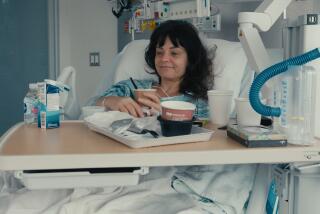A Great Divide Over the Use of Cardiac Donors
- Share via
WASHINGTON — Christine Frank knew one thing for certain on that horrible day when she was told that neither of her teenage sons would survive a car accident.
“I said, ‘Listen to me now. They are to be organ donors. That was their wish,’ ” said Frank, who lost James, 18, and Christopher, 15, in 1998. “When you’re hit with tragedy, if you’re any kind of survivor, you’re going to find something to hold on to, to find it made sense.”
Donating James’ organs was routine. But in most parts of the country, it would have been unlikely -- maybe impossible -- to offer Christopher’s organs.
Christopher died when his heart stopped beating. James, like most organ donors, died when his brain stopped functioning, allowing a ventilator to keep his heart working until his organs were removed.
It is a subtle difference that has vast implications when more than 80,000 people are awaiting transplants and more than 6,000 people die each year while waiting.
Throughout the country, there is a remarkable divide over using organs from people who, like Christopher, die a cardiac death, according to an Associated Press analysis of 2000 and 2001 data. A few of the nation’s 59 organ banks are aggressively using these donors. But nearly half have never handled a case; more than a dozen others have handled only one or two.
Last year, more than half of the 168 cardiac donors nationwide were handled by six organ banks.
No regional pattern can explain the national disparity. In Florida, two banks handle almost no cardiac donors. The state’s other three are among the most aggressive.
Nationally, experts estimate that there could be at least 1,000 cardiac donors each year, with each donor providing two to three organs. These donors could provide enough kidneys and livers to reduce by half the number who die waiting for the organs.
In Philadelphia, where the local organ bank handles more cardiac donors than any other, there have been 151 since 1995.
“That’s a total of 303 organs that would have been buried if we didn’t have this procedure,” said Howard Nathan, executive director of Gift of Life Donor Program.
Still, the pursuit of cardiac donors has raised ethical, medical and technical questions, partly because the organs must be harvested almost immediately after the heart stops beating to prevent deterioration. Among them: How long after a heart stops beating before someone is dead? Are these organs good enough to transplant? Will the process make doctors and nurses nervous?
The Institute of Medicine, which advises the government on medical issues, had hoped to put those questions to rest. In 1997 and again in 1999, the institute concluded that using these donors is “important, medically effective and ethically acceptable.” But there is a lingering sense of discomfort in many parts of the country, even a lack of interest. Often it is hard for doctors and nurses, who are sometimes uncomfortable with removing life support to begin with, said Dr. Christine Cassell, dean of the Oregon Health & Sciences University medical school and head of the institute’s 1999 committee.
For cardiac donation to work, a family must consent before the person is declared dead. Then the medical team must watch the patient die. “That’s a hard thing psychologically for doctors and nurses to do,” Cassell said.
There have also been concerns about the quality of the organs, although recent studies suggest that they work just as well as others. And the logistics are complicated, meaning that hospitals must approve protocols and offer special training.
Hoping to increase the numbers, the United Network for Organ Sharing convened focus groups this year. Most of the more than 200 doctors and nurses who participated knew nothing about cardiac donation, although many said they would support it.
Organ banks in New York, Cleveland, Houston, Denver and elsewhere are beginning to take these donors, and others say they are exploring the idea. Some banks have not given it much thought.
Christine Frank of Cincinnati had talked about organ donation with her sons not six months before they died and knew that is what they wanted.
Retrieving organs from James was relatively straightforward. A ventilator kept his heart pumping and lungs moving while doctors conducted tests that showed he had no brain function, meaning he was brain-dead. To preserve James’ organs, the ventilator stayed on until surgeons could begin harvesting.
A ventilator was also keeping Christopher’s heart pumping. But he had minimal brain function. When a CT scan showed that his brain stem was critically injured, indicating no chance for survival, his parents told doctors to end life support.
Doctors turned off the machine, waited for his heart to stop beating, then waited five more minutes to be sure that it would not start again. At that point, Christopher was officially dead, and doctors could begin harvesting his kidneys.
In some cases of cardiac death, the liver can also be retrieved, although Christopher’s was not usable. Thinking of the two women who received kidneys from Christopher, Christine Frank is baffled that cardiac donation is so rare. “I don’t understand why it’s not being done everywhere,” she said.
More to Read
Sign up for Essential California
The most important California stories and recommendations in your inbox every morning.
You may occasionally receive promotional content from the Los Angeles Times.










